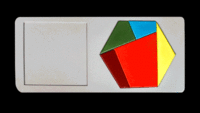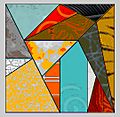Dissection puzzle facts for kids
A dissection puzzle, also called a transformation puzzle or Richter Puzzle, is a tiling puzzle where a set of pieces can be assembled in different ways to produce two or more distinct geometric shapes. The creation of new dissection puzzles is also considered to be a type of dissection puzzle. Puzzles may include various restraints, such as hinged pieces, pieces that can fold, or pieces that can twist. Creators of new dissection puzzles emphasize using a minimum number of pieces, or creating novel situations, such as ensuring that every piece connects to another with a hinge.
Types of dissection puzzle
Some types of dissection puzzle are intended to create a large number of different geometric shapes. The tangram is a popular dissection puzzle of this type. The seven pieces can be configured into one of a few home shapes, such as the large square and rectangle that the pieces are often stored in, to any number of smaller squares, triangles, parallelograms, or esoteric shapes and figures. Some geometric forms are easy to create, while others present an extreme challenge. This variability has ensured the puzzle's popularity.
Other dissections are intended to move between a pair of geometric shapes, such as a triangle to a square, or a square to a five-pointed star. A dissection puzzle of this description is the haberdasher's problem, proposed in 1907 by Henry Dudeney. The puzzle is a dissection of a triangle to a square, in only four pieces. It is one of the simplest regular polygon to square dissections known, and is now a classic example. It is not known whether a dissection of an equilateral triangle to a square is possible with three pieces.
The missing square puzzle, in its various forms, is an optical illusion where there appears to be an equidecomposition between two shapes of unequal area.
-
A Tangram puzzle, with its pieces in the rectangular "storage" configuration.
Images for kids
-
Ostomachion is a dissection puzzle attributed to Archimedes





